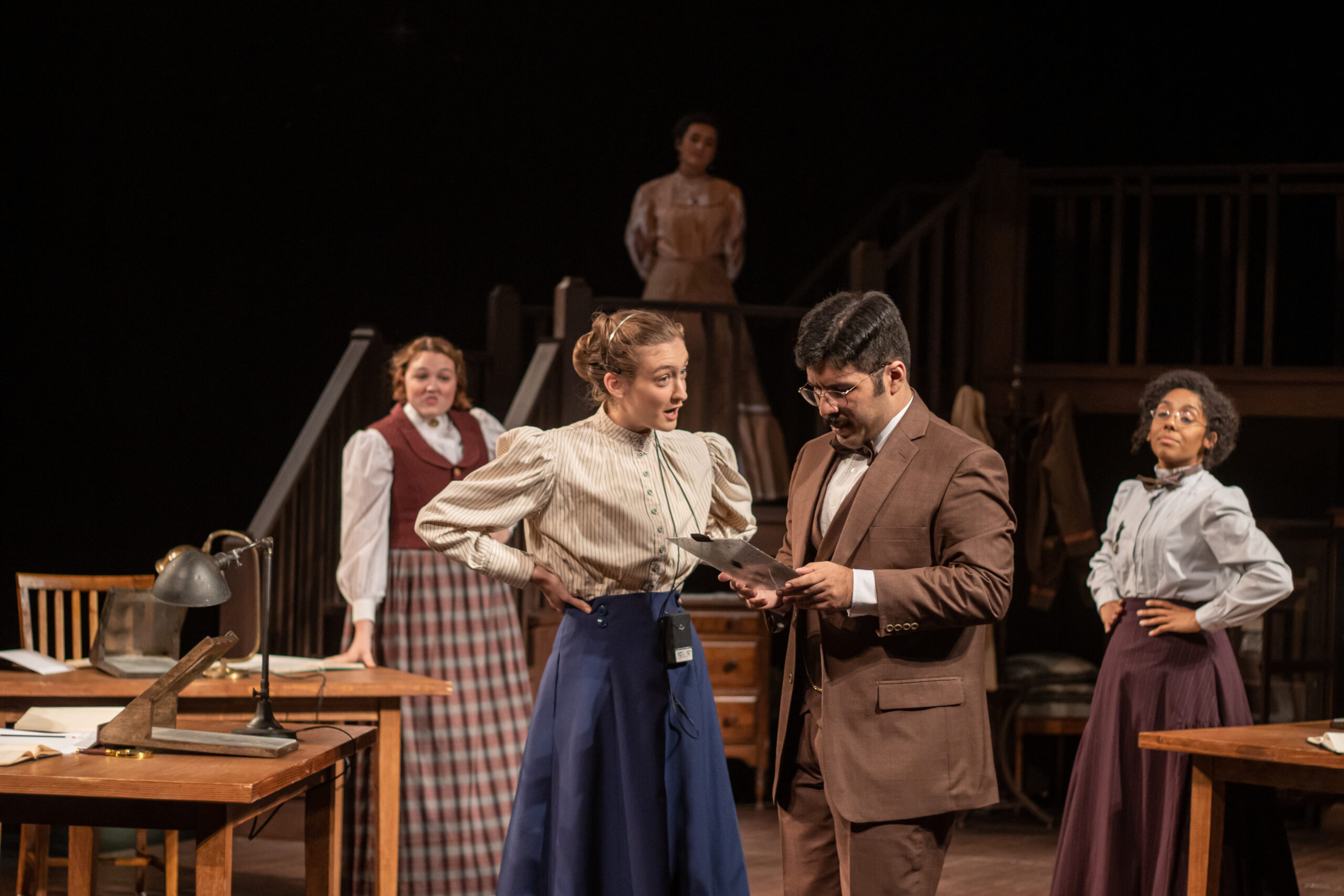The lights are back on in J Studio as URI Theatre welcomes live audiences again. PHOTO CREDIT: Greg Clark
An instrumental version of “Counting Stars” plays. Audience members settle into their seats. The bright lights begin to dim. Suddenly, we’re transported back over 200 years, taken from J Studio in Kingston to Wisconsin, where we learn the story of an overlooked female astronomer who changed the field forever.
In the opening scene of the University of Rhode Island’s production “Silent Sky,” Henrietta Leavitt, expertly portrayed by senior theatre major, Carleigh Boyle, walks out through the audience to stand center stage and deliver her first of multiple monologues on the stars. When we first meet Leavitt, she’s a brilliant young graduate of Radcliffe College, ready to start her career as an astronomer at Harvard College Observatory. She leaves her father and sister Margaret (junior Jenna Wentworth) behind, taking her dowry to follow her dreams. That is until she realizes she won’t be an astronomer, as that is man’s work, but a “computer,” or as her boss Annie Cannon (senior Alana Parrott) explains, “someone who computes.”
For roughly two hours –– including a 15-minute intermission –– the audience is treated to stunning performances by both the actors onstage and the team behind the scenes. Even the transition moments are entertaining, with the stage runners swapping out their traditional all-black outfits for period-specific vests and newsboy caps as they move and rearrange set pieces to diegetic music and vocalization provided by Wentworth, as her character is a composer.
One of the design highlights comes in the form of the costumes, designed by David T. Howard, the chair of the theatre department, and junior Riley Nedder, assistant costume designer. With a small cast of five, it’s clear that Howard and Nedder were able to provide great attention to detail in these early-20th century period pieces. The designs help keep the audience immersed in the time while also allowing them to take a step back into their own and admire the beauty and accuracy.
Perhaps the most important and prominent design feat in this production comes from senior Audrey Visscher, who also served as the assistant director to URI lecturer Tracy Liz Miller. Henrietta and her colleagues spend the show entranced with the stars, both the glass images of them being studied, and the ones hanging in the sky. Through the brilliant work of lighting design, including a particularly spectacular finale, the audience is able to admire, appreciate and learn to understand the stars along with the characters. I have to give additional kudos to the magnificent work from properties designers alumna Lily Ferreira ’20 and Howard for the period-accurate hearing aid Henrietta wears throughout.
With a humorous and powerful script by America’s most-produced playwright, Lauren Gunderson, the five actors have great material to work with and showcase their own talents. Rounding out the small cast are juniors Ben Perreira, who plays astronomer Peter Shaw and Henrietta’s love interest, and Sarah Taylor, who puts on an impressive Scottish accent as computer Williamina Fleming. While much humor is derived from Fleming’s accent, Taylor masters it in such a way that we’re never laughing at Fleming, but rather with her. Perreira also shows a penchant for physical comedy throughout, emphasizing Shaw’s awkwardness around Henrietta that only adds to his charm. Meanwhile, Parrott continues to prove that she can be an intimidating figure (following performances in “Richard III” and “She Kills Monsters”), taking charge, keeping everyone in their place and making sure the work gets done. Cannon’s own work included the development of a star classification still used today but, much like Henrietta, she doesn’t receive nearly as much credit as her male counterparts.
The Leavitt sisters may appear to represent two completely different types of women for their time, with Margie expressing her fear that her sister may never marry and end up a “pants-wearing spinster suffragette,” while Henrietta is concerned primarily with her career, often caring of nothing else. Yet, Margie is supportive nearly to a fault and doesn’t let Henrietta walk all over her or get away with implying that her work is inherently more important than hers as a mother, wife and composer. Wentworth plays the archetype of the quietly strong woman beautifully and powerfully, going toe-to-toe with the almost-domineering character work of Boyle.
From the second she steps onstage, Boyle commands and demands attention, just as Henrietta does, impressing with her abilities and range as both the bold genius in the first act and eventual vulnerable, sickly woman by the play’s end.
While Perreira holds his own, this is a female-dominated production both behind the scenes and onstage. Henrietta and her colleagues are constantly fighting against sexism in the field to be given work, and then be noticed and rewarded for it. The play is at times both disheartening and inspiring, slightly depressing but almost always humorous. The cast plays the dichotomies perfectly.
If only to have an excuse to turn off all your devices for a few hours and laugh among a group of people in a theatre again, go see “Silent Sky” at the Fine Arts Center. Performances will be held Oct. 21-23 at 7:30 p.m., with a closing performance at 2 p.m. on Oct. 24. Tickets can be purchased at the box office or online at URI Theatre’s website.




